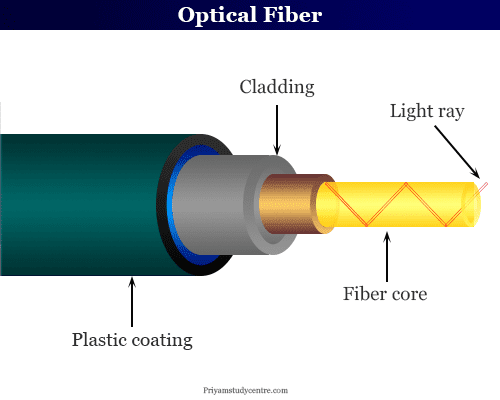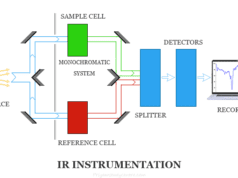Optical Fiber Cable
Optical fiber cable or optical fiber cable is a new development in the field of communication technology that can transmit light along the cable over a considerable distance. It is developed mainly for telecommunication industries. In the latter, it is used for the transmission of light over considerable distances in the spectrophotometer. Optical fiber behaves exactly like an electrochemical sensor. It can transmit light along the cable over a considerable distance. Optical fiber is made by drawing glass (silicon) or plastic which is slightly thicker than that of human hair. The core in fiber optic transmitted light signals and cladding guided the light within the core. Therefore, light transmits along the core is called a waveguide.

Properties of Optical Fiber
Optical fibers have a coaxial core which is surrounded by shielding material of higher refractive index followed by an external coating of a protective buffer. The transmitted light travels by internal reflection within this coaxial core tube. A typical fiber is systematically represented by the following picture,

Numerical Aperture
The numerical aperture (NA) of a fiber is the sine of the largest angle of entering light. It is mathematically represented,
NA = fext b sinα = √(f12 – f22)
Here, f2 = refractive index of cladding
f1 = refractive index of the coaxial core tube
fext = refractive index of the external medium
Numerical aperture (NA) values for different fibers are different. Higher core values with respect to cladding mean larger values of NA. However, increasing NA causes higher scattering loss from a greater concentration of dopant.
Attenuation
The loss of light per unit length at different wavelengths is an equally important property of optical fiber. It is called attenuation and is expressed by unit decibels/km.
Mathematically, attenuation is expressed as,
db = 10 logP0/P
where, P0 = input intensity
P = output intensity of fiber
Types of Optical Fiber Cable
The types and uses of the optical fiber depend on the basis of refractive index, core size, numerical aperture, cladding materials, and mode of propagation of light.
- A compound with the glass itself as the protective coating with a core size of 15 to 75 micrometers is used generally in ultraviolet visible spectroscopy. The numerical aperture (NA) of this type of fiber is 0.5 to 0.8 and the attenuation value is 800 db/km.
- Silica with silicon cladding and a nylon buffer (core size = 100 – 2000 μm, NA = 0.5 – 0.6, attenuation = 200 db/km) is useful for UV and IR regions of the electromagnetic spectrum.
- Silica with suitable cladding material like fluoropolymer, silicon, or doped silica is used generally for long-distance transmission.
According to the mode of propagation of light, optical fibers are of two types, single-mode fibers, and multimode fibers.
- Single-mode fiber: A single-mode optical cable is a glass fiber with a diameter of 8.3 to 10 micrometers with one mode of transmission. It is used generally for the long-distance transmission of signals.
- Multimode fiber: The common diameter range for multimode fibers is 50 to 100 micrometers. These types of fiber generally are used for the short-range transmission of signals.
Uses of Optical Fiber
- Fiber optics is mainly used in telecommunication technology and computer technology due to its fixable behavior low cost and weight. It is very useful for telecommunication technology because of the much lower attenuation values than the electricity in electric cables.
- Optical fiber can be changed into selective absorbance sensors by immobilizing suitable reagents on the extremities of fiber. It operates better than an electrochemical sensor because it does not need of reference electrode.
- For fluorimetric analysis, a fiber optic is fabricated by coating one end with fluorescein isothiocyanate which is pH scale sensitive. Penicillin with a suitable indicator used for enzyme analysis in biosensors.
- Fiber optic technology is also used to transmit power in MRI machines.
- Recently it is developed for the analysis of oxygen and s-block metals.
Advantages of Optical Fiber Communication
Fiber optic technology is very useful because of the less signal degradation. It is more economically effective than electric cables. Optical fiber is also flexible, lightweight, and easy to transport than electric cable.








